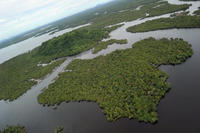-
Cost of plutonium disposal facility skyrockets
The Mixed Oxide (MOX) nuclear fuel factory at the Savannah River Site in South Carolina, being built to help dispose of cold war-era weapon-grade plutonium, would cost up to $30 billion in addition to the $4 billion spent on construction so far. The staggering cost overruns have led many to call for a new, less expensive solution. Matthew Bunn, a former Clinton White House official who helped develop the plutonium disposal program, agrees that the cost of the MOX factory is excessive. “The things we’re trying to accomplish aren’t worth that amount of money,” he said.
-
-
IAEA: Iran's stockpile of 20% enriched uranium shrunk under interim nuclear agreement
The International Atomic Energy Agency (IAEA) reports in its quarterly inspections assessment that the quantity of 20 percent enriched uranium in Iran’s hands has been reduced since last November, when the world’s six powers (P5+1) and Iran have reached an interim agreement on Iran’s nuclear activities. Iran now has 354 pounds of the material — or about one-fifth less than what it had in November. With the right type of centrifuges, it is quicker to enrich uranium from 20 percent to weapon-grade 90 percent than it is to enrich uranium from 1 or 2 percent to 20 percent, so that the smaller the amount of 20 percent uranium a country has, the longer the “breakout” time — the time it would take a country to assemble a nuclear bomb once a decision to do so has been made.
-
-
Operations at a New Mexico nuclear waste repository suspended because of leaks
Operations at the Waste Isolation Pilot Plant, or WIPP, a New Mexico burial site for military nuclear waste, were suspended for the fourth day, the Department of Energy said, after sensors picked up radiation leaks inside salt tunnels where the radioactive material is entombed.Officials said no radiation escaped to the surface.This is the second time this month the facility had to suspend operations. Earlier this month operations were halted after a truck caught fire in an underground tunnel.
-
-
33 A.D. Old Jerusalem earthquake helps determine age of Shroud of Turin

The Shroud of Turin has been at the center of scientific controversy and questions ever since Secondo Pia took the first photograph of it in 1898: whether it is Jesus’s purported burial cloth, how old it might be, and how the image was created. Scientists who conducted radiocarbon dating of the cloth in 1988 determined that the shroud was only 728 years old at the time, and thus that it could not have been in existence during Jesus’s life. Other scientists have since suggested that the shroud is much older, and thus that it could have been produced during Jesus’s time, and that the dating process was incorrect because of neutron radiation — a process which is the result of nuclear fusion or nuclear fission during which free neutrons are released from atoms — and its interaction with the nuclei of other atoms to form new carbon isotopes. No plausible physical reason, however, had been proposed to explain the origin of this neutron radiation – until now: Italian scientists say the source of the neutron emission is a historical earthquake in 33 A.D. in Old Jerusalem, which measured 8.2 on the Richter scale.
-
-
Security of dirty bomb materials in U.S. inadequate: experts
There are more than 5,000 medical and research devices in the United States containing high-activity radiation sources, including 700 with category-1 sources. Category-1 radiation material could be used by terrorists in dirty bombs. The security measures developed by the industry were written with accident prevention in mind, not in order to thwart a deliberate, forcible effort by terrorists or criminals to gain control of the toxic material. In addition, radioactive materials were considered to be “self-protecting,” because it was assumed that the powerful radiation would deter anyone thinking of tampering with these devices. Terrorist bomb-makers, however, showed themselves to be more technologically-savvy than earlier thought, and, in any event, suicide bombers would not be deterred by the risk of radiation poisoning.
-
-
Nuclear physicists prove a Peggy Guggenheim Collection painting is a fake
For more than forty years now, art experts and researchers have been trying to determine whether a painting in the Peggy Guggenheim Collection in Venice was a genuine painting which the French artist Fernand Leger produced between 1913 and 1914 as part of his “Contraste de Formes” series. Scientists from the Instituto Nazionale di Fisica Nucleare (INFN) in Florence have used, for the first time in the art world, a brand new carbon 14 dating method — the so-called “bomb peak” curve, which measures the presence of C-14 in the atmosphere — to establish that the canvas used in the painting was produced in 1959, and thus could not have been used by Leger, who died in 1955.
-
-
Chemical, physical traits of post-nuclear detonation fallout identified
Post-detonation nuclear forensics relies on advanced analytical techniques and an understanding of the physio-chemical processes associated with a nuclear detonation to identify the device type and the source of the nuclear material in the device. Researchers have begun to develop a technique that provides a practical approach for looking into the complex physical and chemical processes that occur during fallout formation following a nuclear detonation.
-
-
NRC: storing spent nuclear fuel in cooling pools is safe
The nuclear reactors now in service in the United States were built with the assumption that the spent fuel would be removed from nuclear the facilities after a few years, but because the government has failed to provide a centralized place to store the spent fuel, utility companies have had to store an ever-growing quantity of it in spent fuel pools on the grounds of the facilities. Scientists argue that it would be safer to move some of the spent fuel into giant steel and concrete casks, where it can be stored dry, with no reliance on water, pumps, or filters to keep them cool. The nuclear industry and the NRC do not agree.
-
-
Arafat died of natural causes, not radiation poisoning: Russian investigators
A team of Russian physicians and scientists investigating the 11 November 2004 death of Palestinian leader Yasser Arafat has concluded that his death was not caused by radiation poisoning. The conclusions of the Russian team are a blow to the Palestinian leadership, which, since 2004, has accused Israel of being behind Arafat’s death. The Russian team’s findings follow the findings of two other scientific investigative teams: a Swiss medical team, funded by Arafat’s widow, concluded that the radiation poisoning of Arafat could not be ruled out. The French scientific team, appointed by a French judge, concluded that the levels of polonium-210 in Arafat’s personal effects, and the complete absence of the radioactive isotope in his body tissues, made it impossible for Arafat to have been poisoned by polonium. The Russian team, hired by the Palestinian authority, reached the same conclusion the French team did. “It was a natural death; there was no impact of radiation,” Vladimir Uiba, the head of the Russian Federal Medical and Biological Agency, said.
-
-
Uranium found to be mobile in a natural wetland

Because they are known to mop up pollutants, artificial wetlands are considered to be an efficient strategy to contain waterborne uranium. Studying a natural wetland near a former uranium-mining site in the French region of Limousin, however, researchers have found that under certain circumstances, uranium can be partly remobilized into the surrounding water. The researchers show how it becomes mobile again by binding to tiny metallic and organic compounds with a little help from ambient bacteria.
-
-
Stolen nuclear material found intact in Mexico
Mexican police yesterday said they have found a truck, a white 2007 Volkswagen cargo vehicle, which was stolen Monday by thieves who apparently were not aware that it was carrying toxic radioactive medical material from a hospital to a disposal site. The cobalt-60 the truck was carrying could be used to build a “dirty bomb.” The IAEA said that more than 100 incidents of thefts and other unauthorized activities involving nuclear and radioactive material are reported to the agency annually.
-
-
Yasser Arafat was not poisoned: French investigators

French scientific and medical experts rule out possibility that Palestinian leader was poisoned by radioactive polonium-210. A Russian medical team examining tissue samples taken from Arafat’s body reached the same conclusion three months ago. The conclusions of a Swiss medical team were more ambiguous. Leaders of the Palestinian Authority began accusing Israel of poisoning Arafat even before he died, as his health was rapidly declining. Israel has consistently denied the accusation, describing it as “unreasonable and unsupported by facts.”
-
-
Arafat may have been poisoned, but what is polonium?

A Swiss forensic report of the exhumed remains of ex-Palestinian leader Yasser Arafat last month suggested polonium poisoning may have been the cause of death – but what is polonium, and why is it so deadly? Polonium is a highly radioactive heavy metal. It is arguably the most lethal known material. Although it has some minor industrial uses it is best known for links with possible assassinations. It is also used to produce neutrons in the core of nuclear weapons. Polonium is element 84 in the periodic table, and all of its isotopes are radioactive. Their half-lives vary between a few millionths of a second to 103 years.
-
-
The interim agreement between the P5+1 and Iran: the details
The P5+1 countries (the United States, United Kingdom, Germany, France, Russia, and China, facilitated by the European Union) have been engaged in negotiations with Iran in an effort to reach a verifiable diplomatic resolution which would prevent Iran from obtaining a nuclear weapon. On Sunday, the P5+1 and Iran reached a set of initial understandings which halts, at least temporarily, the progress of Iran’s nuclear program and rolls it back in key respects. In return, for Iran’s concessions, and as part of this initial step, the P5+1 will provide what the agreement describes as “limited, temporary, targeted, and reversible” relief to Iran.
-
-
New drone to monitor radiation following nuclear disasters

Researchers have unveiled a large semi-autonomous drone called the ARM system which could be used to provide visual and thermal monitoring of radiation after a release of nuclear material. The system was developed in response to requirements for radiation monitoring in event of the release of radioactive materials.
-
- All
- Regional
- Water
- Biometrics
- Borders/Immig
- Business
- Cybersecurity
- Detection
- Disasters
- Government
- Infrastructure
- International
- Public health
- Public Safety
- Communication interoperabillity
- Emergency services
- Emergency medical services
- Fire
- First response
- IEDs
- Law Enforcement
- Law Enforcement Technology
- Military technology
- Nonlethal weapons
- Nuclear weapons
- Personal protection equipment
- Police
- Notification /alert systems
- Situational awareness
- Weapons systems
- Sci-Tech
- Sector Reports
- Surveillance
- Transportation
Advertising & Marketing: advertise@newswirepubs.com
Editorial: editor@newswirepubs.com
General: info@newswirepubs.com
2010-2011 © News Wire Publications, LLC News Wire Publications, LLC
220 Old Country Road | Suite 200 | Mineola | New York | 11501
Permissions and Policies
Editorial: editor@newswirepubs.com
General: info@newswirepubs.com
2010-2011 © News Wire Publications, LLC News Wire Publications, LLC
220 Old Country Road | Suite 200 | Mineola | New York | 11501
Permissions and Policies
